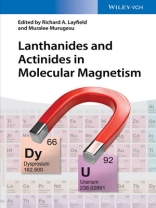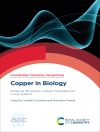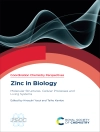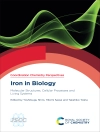The first reference on this rapidly growing topic provides an essential up-to-date guide to current and emerging trends.
A group of international experts has been carefully selected by the editors to cover all the central aspects, with a focus on molecular species while also including industrial applications.
The resulting unique overview is a must-have for researchers, both in academia and industry, who are entering or already working in the field.
Зміст
Preface XIII
List of Contributors XV
1 Electronic Structure and Magnetic Properties of Lanthanide Molecular Complexes 1
Lorenzo Sorace and Dante Gatteschi
1.1 Introduction 1
1.2 Free Ion Electronic Structure 3
1.2.1 Free Ion Magnetism 6
1.3 Electronic Structure of Lanthanide Ions in a Ligand Field 7
1.3.1 Stevens’ Formalism 9
1.3.2 Wybourne’s Formalism 9
1.3.3 Standardization 13
1.3.4 Calculation of Crystal Field Parameters 13
1.4 Magnetic Properties of Isolated Lanthanide Ions 16
1.4.1 Effect of a Magnetic Field 16
1.4.2 EPR Spectroscopy of Lanthanide Complexes 17
1.5 Exchange Coupling in Systems Containing Orbitally Degenerate Lanthanides 21
Acknowledgements 23
References 23
2 Mononuclear Lanthanide Complexes: Use of the Crystal Field Theory to Design Single-Ion Magnets and Spin Qubits 27
Juan M. Clemente-Juan, Eugenio Coronado, and Alejandro Gaita-Ari ̃no
2.1 Introduction 27
2.2 Modelling the Magnetic Properties of Lanthanide Single-Ion Magnets:The Use of the Crystal Field Model 29
2.2.1 Theoretical Background 29
2.2.2 How to Determine the Crystal-Field Parameters: 1. The Ishikawa Approach 30
2.2.3 How to Determine the Crystal-Field Parameters: 2. The Point Charge Electrostatic Model 34
2.2.4 How to Determine the Crystal-Field Parameters: 3. The Effective Point Charge Model 36
2.3 Magneto-Structural Correlations for Some Typical Symmetries 40
2.4 Impact of Lanthanide Complexes in Quantum Computing 44
2.4.1 Quantum Computing Paradigms and Design Criteria 45
2.4.2 Combining Physical Qubit Implementations with Lanthanide Complexes 48
2.4.3 Molecular Spin Qubits 50
2.5 Conclusions 53
Acknowledgements 54
References 55
3 Polynuclear Lanthanide Single Molecule Magnets 61
Jinkui Tang and Peng Zhang
3.1 Introduction 61
3.2 Synthetic Strategies 62
3.2.1 Dy3 Triangles and Their Derivatives 64
3.2.1.1 Seminal Dy3 Triangle 64
3.2.1.2 Other Triangular Dy3 Systems 65
3.2.1.3 The Coupling of Dy3 Triangles 68
3.2.2 Linear Polynuclear Lanthanide Complexes Showing Robust SMM Behaviour 71
3.2.2.1 Linear Dy3 SMMs 72
3.2.2.2 Linear Dy4 SMMs 73
3.2.3 Planar Dy4 SMMs 75
3.2.4 Dyn SMMs Having Multiple μn-O (n > 4) Bridges 78
3.2.4.1 The Dy4 Grids Fixed by μ4-O Atom 78
3.2.4.2 The Dy4 Tetrahedron Fixed by μ4-O Atom 80
3.2.4.3 The Dy5 Pyramid Fixed by μ5-O Atom 80
3.2.5 Hydrazone-Based Lanthanide SMMs 82
3.2.5.1 The Assembly of Dy6 Triangular Prism with Dy2 Units 83
3.2.5.2 A Dy3 Molecular Cluster Pair (Dy6) 84
3.2.6 The Organometallic Synthesis—A New Approach 85
3.3 Conclusion 86
References 86
4 Lanthanides in Extended Molecular Networks 89
Roberta Sessoli and Kevin Bernot
4.1 Introduction 89
4.2 Extended Networks Based on Gd3+ 91
4.2.1 Metal-Organic Frameworks 91
4.2.1.1 Magneto-Caloric Effect 91
4.2.1.2 Slow Magnetic Relaxation and Phonon Bottleneck Effects 94
4.2.2 Magnetic Chains 96
4.2.2.1 Magnetic Interactions Involving Gd3+ Ions 96
4.2.2.2 Gadolinium-Radical Chains 96
4.3 Extended Networks Based on Anisotropic Ions 101
4.3.1 SCM in a Nutshell 101
4.3.2 An Overview of Monodimensional Lanthanide Chains Based on Anisotropic Ions 104
4.3.2.1 Chains Based on 4f Ions 104
4.3.2.2 Chains Based on 3d–4f Ions 106
4.3.2.3 Chains Based on Radicals and 4f Ions 111
4.3.3 The Key Point of Noncollinearity of Magnetic Anisotropy 112
4.4 Conclusions 119
References 119
5 Experimental Aspects of Lanthanide Single-Molecule Magnet Physics 125
Kasper S. Pedersen, Daniel N.Woodruff, Jesper Bendix, and Rodolphe Clérac
5.1 Introduction 125
5.2 Manifestation of Single-Molecule Magnet Behaviour 127
5.2.1 Magnetization and ac Susceptibility Measurements 127
5.2.2 NMR Spectroscopy 132
5.2.3 Muon Spin Rotation 133
5.3 Quantifying the Magnetic Anisotropy 135
5.4 Splitting of the Ground Multiplet 139
5.4.1 Magnetic Resonance Spectroscopies 139
5.4.2 Luminescence Spectroscopy 140
5.4.3 Inelastic Neutron Scattering 141
5.5 Observation of the Signatures of Exchange Coupling 146
5.5.1 Chemical Substitution 146
5.5.2 X-Ray Magnetic Circular Dichroism 147
5.6 Concluding Remarks and Perspectives 149
References 150
6 Computational Modelling of the Magnetic Properties of Lanthanide Compounds 153
Liviu Ungur and Liviu F. Chibotaru
6.1 Introduction 153
6.2 Ab Initio Description of Lanthanides and its Relation to Other Methods 153
6.2.1 Ab Initio Approach for the Electronic Structure of Lanthanides 155
6.2.1.1 Accounting for Static Electron Correlation within CASSCF 155
6.2.1.2 Accounting for Dynamical Electron Correlation: An Important Step Towards Accurate Predictions 155
6.2.1.3 Accounting for Relativistic Effects within the Douglas–Kroll–Hess Theory 156
6.2.1.4 Spin–Orbit Multiplets of Free Lanthanide Ions: Relativistic CASSCF/RASSIMethod in Work 157
6.2.2 Ab Initio Versus Two-Component DFT 159
6.2.3 Ab Initio Versus Phenomenological Crystal Field Theory for Lanthanides 159
6.3 Ab Initio Calculation of Anisotropic Magnetic Properties of Mononuclear Complexes 160
6.3.1 Implementation of Ab Initio Methodology: SINGLE_ANISO Program 161
6.3.2 Temperature-Dependent Magnetic Susceptibility and Field-Dependent Magnetization 163
6.3.3 Magnetic Anisotropy in Low-Lying Doublets 164
6.3.4 Ab Initio Crystal Field 166
6.4 Ab Initio Calculation of Anisotropic Magnetic Properties of Polynuclear Complexes 169
6.4.1 Two-Step Approach for the Calculation of Electronic Structure of Polynuclear Lanthanide Complexes 170
6.4.2 Key Rules for Cluster Fragmentation 170
6.4.3 Implementation of Ab Initio Methodology: POLY_ANISO Program 171
6.4.4 Noncollinear Magnetic Structure of Lnn Complexes 172
6.4.5 Mixed Lanthanide-Transition Metal Compounds 176
6.4.6 Lanthanide-Containing Magnetic Chains 178
6.5 Conclusions 180
References 181
7 Lanthanide Complexes as Realizations of Qubits and Qugates for Quantum Computing 185
Guillem Aroḿ ı, Fernando Luis, and Olivier Roubeau
7.1 Introduction to Quantum Computation 185
7.1.1 General Introduction 185
7.1.2 Definition of Qubits, Qugates, Timescales and Essential Requirements 186
7.1.3 Current Proposals for the QC Hardware 189
7.1.3.1 Trapped Ions 189
7.1.3.2 Nuclear Spins 190
7.1.3.3 Superconducting Qubits 191
7.1.3.4 Spin Qubits 191
7.1.3.5 Photons 191
7.1.3.6 Hybrid Proposals and Quantum Circuits 192
7.2 Quantum Computing with Electron Spin Qubits 192
7.2.1 Electronic Spins in Semiconductors: QDs and Dopants 192
7.2.1.1 Quantum Dots 193
7.2.1.2 Dopants and Defects 193
7.2.2 Electronic Spins in Molecules: Organic Radicals and Transition Metal Complexes 194
7.2.2.1 Organic Radicals 194
7.2.2.2 Transition Metal Complexes 195
7.3 Single Lanthanide Ions as Spin Qubits 197
7.3.1 Quantum Coherence of Lanthanide Ions Doped into Crystalline Solids 198
7.3.2 Control of the Magnetic Anisotropy of Lanthanide Ions: Chemical Design of Spin Qubits 199
7.3.2.1 Mononuclear Single Molecule Magnets 199
7.3.2.2 Gadolinium(III) POMs as Spin Qubits 200
7.3.2.3 Mononuclear SMMs of Ln(III) Ions with Nonzero Orbital Moment 202
7.4 Lanthanide Molecules as Prototypes of Two-Qubit Quantum Gates 204
7.4.1 A Family of Asymmetric [Ln2] Complexes with Weak Magnetic Coupling 204
7.4.2 Heterometallic [Ln Ln′] Complexes: A Fabric of Chemical Asymmetry and Individual Qubits 208
7.4.3 Evaluating Qubit Properties 209
7.4.4 Weak Coupling 211
7.4.5 Asymmetry and Energy Diagrams 212
7.4.6 Decoherence of the Molecular Quantum Processor Prototypes 215
7.5 Conclusions and Outlook 215
References 216
8 Bis(phthalocyaninato) Lanthanide(III) Complexes – from Molecular Magnetism to Spintronic Devices 223
Yanhua Lan, Svetlana Klyatskaya, and Mario Ruben
8.1 Introduction 223
8.1.1 Molecular Magnetism 223
8.1.2 Multinuclear Versus Mononuclear: d- Versus f-Metal Ions 224
8.1.3 Molecular Versus Organic Spintronics 227
8.2 Synthesis and Structure of Ln Pc2 Complexes 229
8.2.1 Synthesis of Bis(phthalocyaninato) Lanthanide(III) Complexes 229
8.2.2 Synthesis of Heteroleptic Lanthanide(III) Complexes Containing Porphyrin-Based Ligands 235
8.2.3 Oxidation States of Bis(phthalocyaninato) Lanthanide(III) Complexes 239
8.2.4 Rotation Angles and Skew Angles in Ln Pc2 in Relation to the Lanthanide Contraction 243
8.3 Bulk Magnetism of Ln Pc2 Complexes 246
8.3.1 Magnetism of Bis(phthalocyaninato) Lanthanide(III) Complexes 246
8.3.2 Three Spin Systems in [Tb Pc2]0 Single-Ion Molecular Magnets (SIMMs) 246
8.3.2.1 The Organic Radical (S) 246
8.3.2.2 The Electronic Spin (J) 248
8.3.2.3 The Nuclear Spin (I) 249
8.3.3 Further SIMs of Ln Pc2 with Ln =Tb, Dy and Ho 249
8.3.4 Internal Kondo in Ln Pc2 Complexes with Ln = Ce, Yb 255
8.3.5 Stable Organic Radicals S = 1∕2 in Ln Pc2 with Ln = Y, Lu 257
8.3.6 A Special Case: Half-Filling of the f-Orbitals in Gd Pc2 and its Consequences 258
8.4 Surface Magnetism of Ln Pc2 Complexes 259
8.4.1 Deposition of [Tb Pc2]0 SIMMs on Nonmagnetic Substrates 261
8.4.1.1 Highly Oriented Pyrolitic Graphite 261
8.4.1.2 Au(111) 262
8.4.1.3 Cu(111) 263
8.4.1.4 Cu(100) 265
8.4.2 Deposition of [Tb Pc2]0 SIMs on Magnetic Substrates 267
8.4.2.1 Nickel Thin Films 267
8.4.2.2 Cobalt Thin Films 269
8.4.2.3 LSMO 269
8.4.2.4 Manganese and Cobalt Oxide Layers 269
8.4.2.5 Spin Polarized Scanning Tunnelling Microscopy (SP-STM) on Co/Ir(111) 270
8.5 Molecular Spintronic Devices on the Base of [Tb Pc2]0 SIMs 272
8.5.1 Graphene Transistor 274
8.5.2 Supramolecular Spin Valve 276
8.5.3 Molecular Spin Resonator 278
8.5.4 Molecular Spin Transistor 280
8.6 Conclusion and Outlook 281
Abbreviations 283
References 284
9 Lanthanides and the Magnetocaloric Effect 293
Joseph W. Sharples and David Collison
9.1 Applications of Magnets 293
9.2 Cold Reasoning 294
9.3 Current Technologies 294
9.4 How Paramagnets Act as Refrigerants 295
9.5 More Parameters 297
9.6 Aims 298
9.7 Important Concepts for a Large Magnetocaloric Effect 298
9.7.1 Spin 298
9.7.1.1 Examples 299
9.7.2 Nature of Exchange Coupling 301
9.7.2.1 Paramagnetism 301
9.7.2.2 Ferromagnetism 303
9.7.2.3 Antiferromagnetism 304
9.7.3 Active Metal Percentage 305
9.7.4 Density 307
9.7.5 Anisotropy or Spin: What Kind? 308
9.7.6 Dimensionality 310
9.8 High-Performance MCE Materials 311
9.9 Outlook 312
References 313
10 Actinide Single-Molecule Magnets 315
Stephen T. Liddle and Joris van Slageren
10.1 Introduction 315
10.2 Literature Survey of Published Actinide Single-Molecule Magnets 322
10.2.1 Single-Molecule Magnets of f3 Actinides (U3+, Np4+) 322
10.2.2 Single-Molecule Magnets of f1 Actinides (U5+) 330
10.2.3 Miscellaneous: {Np VIO2Cl2}{Np VO2Cl(THF)3}2 (15) 332
10.3 Magnetic Coupling in Actinides 332
10.3.1 5f–5f Couplings 333
10.3.2 5f–4f Couplings 335
10.3.3 5f–3d Couplings 335
10.3.4 5f–2p Couplings 336
10.4 Conclusions 336
References 336
Index 341
Про автора
Richard Layfield is a Reader in Inorganic Chemistry at The University of Manchester, UK. He obtained his undergraduate degree in Chemistry at the University of Leeds, UK, and his Ph D in Inorganic Chemistry at the University of Cambridge, UK. He has received several awards, including an Alexander von Humboldt Foundation Fellowship for Experienced Researchers, and the Royal Society of Chemistry Meldola Medal and the Sir Edward Frankland Fellowship.
Muralee Murugesu is an Associate Professor at the University of Ottawa, Canada. He studied Chemistry at the University of Paris 7 Jussieu, France. Afterwards he obtained his MSc in Chemistry at the University of East Anglia, UK, and Ph D in Chemistry at the University of Karlsruhe, Germany. His first postdoctoral appointment was at University of Florida with Prof. George Christou, followed by a postdoctoral position working jointly between the University of California, Berkeley and the University of California, San Francisco under the supervision of Prof. Jeffrey Long and the Nobel Laureate Prof. Stanley Prusiner.












